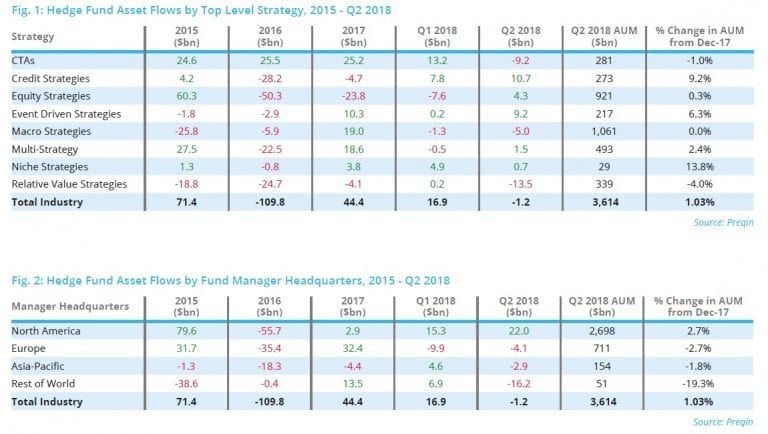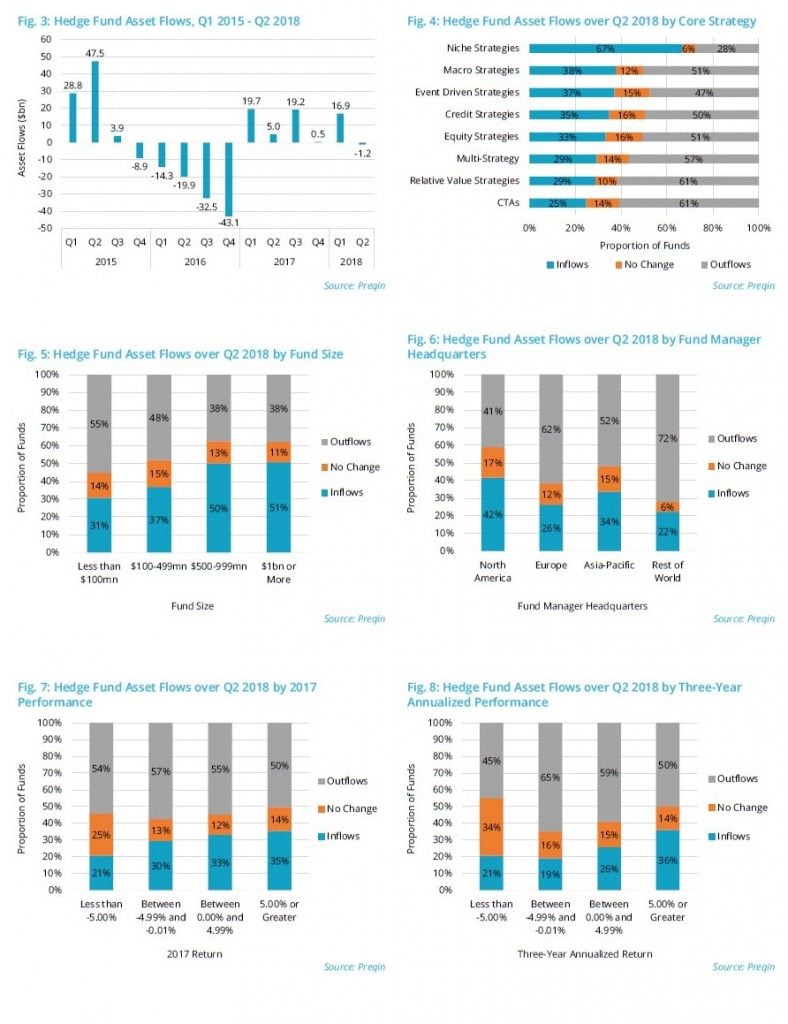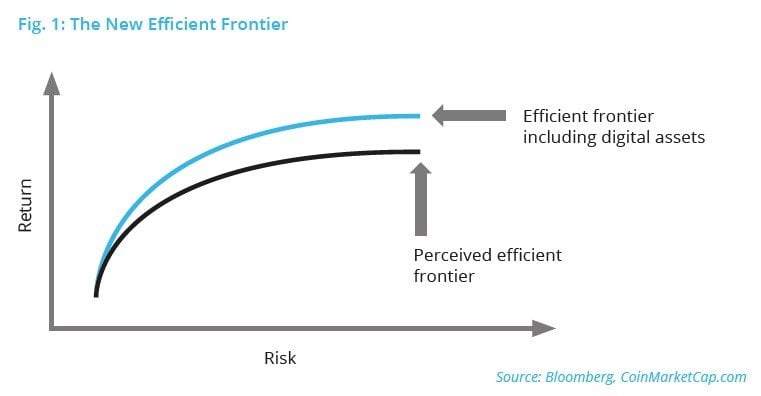In this month’s Hedge Fund Spotlight, Preqin looks at hedge fund asset flows in H2 2018 by strategy, fund size, manager headquarters and performance.
Q2 2018 Hedge Fund Asset Flows
Using data from Preqin’s online platform, we look at hedge fund asset flows in Q2 2018 by strategy, fund size, manager headquarters and performance.
Related: Top 50 Hedge Fund ETFs
In Q2 2018, hedge funds recorded their first quarterly outflows since Q4 2016. Despite investors withdrawing $1.2bn in capital in Q2 2018, performance has driven hedge fund industry assets under management (AUM) to a record high of $3.61tn as at June 2018 (Fig. 1).
Credit strategies attracted the greatest volume of inflows ($10.7bn) in Q2, helping to bring H1 2018 net asset flows to $18.5bn – the greatest of any top-level hedge fund strategy tracked by Preqin. Event driven strategies closely followed with net asset flows of $9.2bn in Q2 2018; following these capital inflows, as well as consistent performance throughout the quarter, AUM for the strategy reached $217bn, marking an increase of 6.3% since the end of 2017.
North America was the only region tracked by Preqin to generate net inflows in Q2 2018: fund managers based in the region attracted an influx of capital totalling $22.0bn (Fig. 2), with 42% of North America-based fund managers witnessing inflows (Fig. 6). European outflows persisted for the second quarter of 2018, totalling $13.9bn for the year so far. In addition, only 26% of Europe-based funds recorded inflows during Q2, while 62% were subject to net outflows. Asia-Pacific and Rest of World regions also recorded outflows amounting to $2.9bn and $16.2bn respectively.
When examining asset flows by fund size, Preqin data suggests that capital is heading into the hands of the larger funds. Fifty-one percent of funds that hold AUM greater than $1bn experienced inflows in Q2 2018 (Fig. 5). In contrast, among funds less than $100mn in size, only 31% observed inflows while 55% were subject to outflows, indicating that investors are looking to the safer option of the larger fund managers.
A fund manager’s ability to attract new capital is heavily reliant on its track record. Thirty-five percent of funds that posted a return of 5.00% or greater for 2017 recorded inflows during the second quarter of 2018 (Fig. 7). This is in contrast to funds that returned less than -5.00%, with only 21% of these funds generating inflows. Similar trends can also be identified over the longer term: 36% of funds with a three-year annualized return of 5.00% or higher made inflows, while in comparison, only 21% of those that returned less than -5.00% over the period achieved the same (Fig. 8).
![]()
A New Frontier: How Digital Assets Are Reshaping Asset Allocation
– Matthew Beck, Grayscale Investments
It is not every day, or even every decade, that an entirely new asset class is born. Yet, through a combination of computer science, cryptography, economics and network theory, digital assets have arrived and are proving an asset class unlike any other. As they transform our global financial infrastructure and challenge modern monetary theory1, we believe digital assets are one of the most exciting investment opportunities of the 21st century.
In this paper, we will demonstrate why we view digital assets as a new asset class that can enhance strategic asset allocation and help investors build portfolios with higher risk-adjusted returns. Since the focus of this paper is portfolio construction, we will not go deep into detail on the investment merits of individual digital assets. However, we encourage you to review our previous investment theses for select digital assets here.
Building Better Portfolios With Digital Assets
“Diversification is the one free lunch of investing, and when you see a free lunch, the only rational thing to do is eat.”2 – Cliff Asness, Managing Principal and CIO at AQR Capital Management
New asset classes are rare and powerful because they offer a unique return stream that can diversify a portfolio. This might seem like a simple concept, but few investors truly appreciate the impact this can have on the return/risk profile of a portfolio, and subsequent wealth creation. Consistent with Modern Portfolio Theory, we generally subscribe to the notion that the optimal return/risk ratio for a portfolio can be found on the efficient frontier. But contrary to conventional wisdom, we think many of today’s asset allocators are missing out on a “free lunch.” That’s because (i) digital assets represent a brand-new investment opportunity that is uncorrelated to other asset classes and (ii) investors are generally under-allocated to this sector. It is our view that the optimal beta portfolio3 lies somewhere higher than what was previously believed to be the efficient frontier, and digital assets are the proverbial “missing piece of the puzzle.”
Digital currencies, like Bitcoin, seek to fulfill the role of a decentralized global currency and store-of-value. Others, like Zcash (ZEC) and Monero (XMR), build upon Bitcoin’s role by offering privacy-enhancing features. Digital commodities, like Ethereum (ETH), fuel decentralized applications (DApps) which can execute condition-based transactions through the use of smart contracts, while assets like Ethereum Classic (ETC) are a hybrid currency and commodity, combining the monetary attributes that have made Bitcoin a digital store-of-value with the smart contract capabilities of Ethereum. These are just a few examples of how digital assets are functioning today.
Moreover, digital assets are at the intersection of some of the most significant trends reshaping the global economy4, including:
- A new market paradigm characterized by slow growth and divergent central bank policies.
- Advancements in financial technologies and payment infrastructure.
- Regulatory shifts, altering financial industry economics and significantly increasing the cost of compliance.
- Demographic shifts, driven by (i) the next generation of investors entering their prime earning years (i.e. millennials) and (ii) impending retirement obligations, financed primarily by equity and bond investments.
Combining the growth opportunities that digital assets offer as a revolutionary technology and the store-of-value characteristics that many of them possess as alternative currencies, digital assets may have the potential to provide both inflation protection and growth exposure concurrently.



